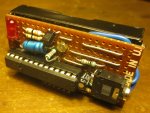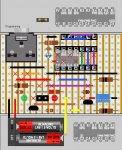6:9:0 BattmV= 2938,Vcc= 2941,I= 100 mA,PWM= 568
6:9:30 BattmV= 2921,Vcc= 2924,I= 101 mA,PWM= 575
*Log*
6:10:0 BattmV= 2921,Vcc= 2924,I= 100 mA,PWM= 575
6:10:30 BattmV= 2904,Vcc= 2907,I= 100 mA,PWM= 577
6:11:0 BattmV= 2887,Vcc= 2890,I= 100 mA,PWM= 579
6:11:30 BattmV= 2870,Vcc= 2873,I= 100 mA,PWM= 582
6:12:0 BattmV= 2853,Vcc= 2856,I= 100 mA,PWM= 587
6:12:30 BattmV= 2836,Vcc= 2839,I= 100 mA,PWM= 592
6:13:0 BattmV= 2819,Vcc= 2822,I= 99 mA,PWM= 593
6:13:30 BattmV= 2819,Vcc= 2822,I= 100 mA,PWM= 596
6:14:0 BattmV= 2802,Vcc= 2805,I= 100 mA,PWM= 600
6:14:4 BattmV= 2802,Vcc= 2805,I= 58 mA,PWM= 0
6hrs 14mins at 100mA = 620 mAhr,1987 mWhr,5 mins Log
Mins: mV
0 3345
5 3294
10 3294
15 3294
20 3294
25 3294
30 3294
35 3294
40 3294
45 3294
50 3294
55 3294
60 3294
65 3294
70 3294
75 3294
80 3294
85 3294
90 3277
95 3294
100 3277
105 3277
110 3277
115 3277
120 3260
125 3260
130 3260
135 3260
140 3260
145 3260
150 3260
155 3260
160 3260
165 3260
170 3260
175 3260
180 3243
185 3243
190 3243
195 3243
200 3243
205 3243
210 3243
215 3243
220 3243
225 3243
230 3243
235 3243
240 3243
245 3243
250 3226
255 3226
260 3226
265 3226
270 3226
275 3209
280 3209
285 3209
290 3209
295 3192
300 3192
305 3192
310 3192
315 3175
320 3175
325 3158
330 3141
335 3124
340 3124
345 3124
350 3107
355 3090
360 3073
365 3006
370 2921
6:14:4 BattmV= 2972,Vcc= 2975,I= 1 mA,PWM= 0
6hrs 14mins at 100mA = 620 mAhr,1987 mWhr,5 mins Log
Mins: mV
0 3345


